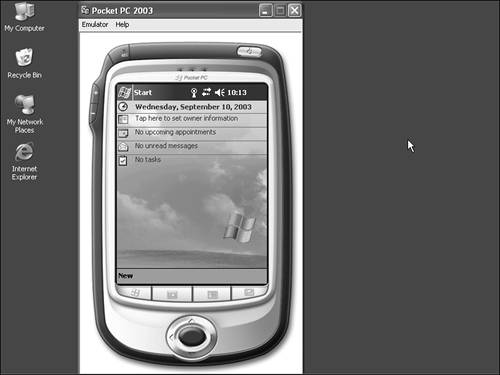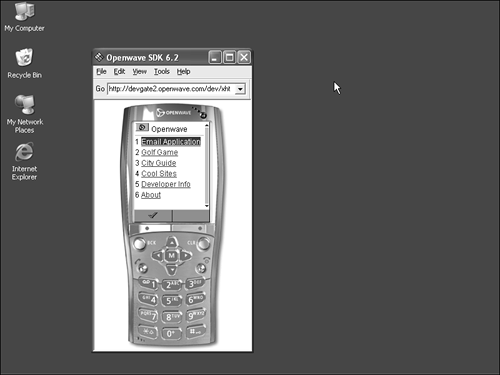Designing the Appropriate Use of Exchange 2003 Mobility Capabilities
| < Day Day Up > |
| When implementing Exchange 2003 with the expectation of using the Exchange ActiveSync and Outlook Mobile Access functionality, an Exchange design architect needs to determine the best way to take advantage of the technology. Fortunately, the ActiveSync and Outlook Mobile Access functions are relatively low in bandwidth and processing demands on the Exchange environment, so a single server can typically scale to the initial needs of most organizations. Design and scalability of Exchange 2003 mobility do not necessarily require a lot of performance planning, but you do need the right technology for the expected use. Identifying Mobile Devices in UseIn defining the organization's use of mobile devices, such as PDAs and mobile phones, it's helpful to start with understanding what type of devices are currently used in the organization. Because there's been neither industry standardization nor support for common gateway or integration products, most organizations have one of every type of mobile device available in their organization. When trying to support one of every device, the organization is challenged with trying to meet the integration and education needs of several different types of devices, and in many cases trying to support devices that do not necessarily meet the needs of the user (s) in the first place. So rather than trying to support every type of device in the organization, the initial inventory should be intended at understanding the devices in use. To determine the type of devices used and the basic connectivity, ask users to fill out a questionnaire similar to the one in Table 22.1. Table 22.1. Identifying Mobile Devices in Use
Users who are determined to have mobile devices should be asked questions to determine their current use of email, calendaring, or other synchronization of information. Ask users questions similar to the ones shown in Table 22.2. Table 22.2. Identifying Mobile Device Features
Other questions, such as those in Table 22.3, help determine whether the mobile device should be prioritized for integration to Exchange 2003. Table 22.3. Identifying Exchange 2003 Integration Potential
Frequently determined from the answers to these various questionnaires is that most users have minimal mobile information access needs and use their current mobile device for a limited set of features. So rather than trying to integrate every mobile device in the organization to Exchange 2003 initially, identify the users who have the most need and the most functional use of their mobile device now, and add those users to the first round of Exchange 2003 “integrated devices. Then add additional users in waves, based on need and anticipated value received from the integration. Quite commonly, users aren't happy with the device they are using, and connecting their device to Exchange 2003 will still not improve the device or how they use it. So rather than integrating devices that do not meet the need of the users, wait until other users get functional use out of Exchange 2003, and consider recommending a standardization of future mobile devices throughout the organization, based on the successful use by the first few waves of users. Choosing the Right Mobile SolutionAfter interviewing users in the organization about their use of mobile devices, you might find that certain devices meet user needs and other devices do not. There are frequently two types of users: those that are heavy email users and those that are heavy phone users. Trying to make a phone user into a mobile email user, or vice versa, usually does not result in improved user satisfaction. A mobile phone with 3 “4 8-character lines and a numeric phone keyboard is not a device that best suits someone that needs extensive email capabilities. A Pocet PC device that has full Outlook capabilities but does not have public mobile wireless access also lacks appropriate functionality. Exchange 2003 has the tools and the functionality to meet the needs of organizations, so it's up to the organization to match users with appropriate devices that can then connect to the fully equipped Exchange 2003 environment. Understanding Exchange ActiveSync and OMAAn easy way to understand how Exchange 2003 works for mobile users is to leverage the mobile device emulators and software developer's kits for Pocet PC and HTML-based mobile phone units. It's a lot easier and a lot cheaper to download the emulation tools than to buy hardware, set up mobile services, and do initial feature and function testing on real devices. For Pocet PC functionality testing, Microsoft has a Pocet PC developer's kit that comes with a full functioning Pocet PC emulator. You can download the emulator from Microsoft's homepage at http://www.microsoft.com/windowsmobile/information/devprograms/default.mspx The software developer's kit, also known as the Windows Mobile 2003 SDK, comes with an emulation program, similar to the one shown in Figure 22.2, that enables you to connect to a network, establish an Exchange ActiveSync connection to Exchange 2003, and synchronize email, calendar, contacts, and other information between Exchange 2003 and this Pocet PC-emulated device. Figure 22.2. Microsoft Pocet PC emulator. The Pocet PC emulator requires the installation of eMbedded Visual C++ 4 along with eMbedded Visual C++ Service Pack 2 or higher to run. The emulator can be installed on any workstation connected to the network that the Exchange 2003 server is connected to, or the emulator can be set to VPN from another segment into a RRAS server on the network where the Exchange 2003 server resides. Similar functionality can be emulated for a mobile phone. Openwave makes a mobile phone simulator, shown in Figure 22.3, that can be downloaded free from its Website: http://www.openwave.com/products/developer_products/omdt/client_sdk.html Figure 22.3. Openwave mobile phone simulator. This emulator enables the testing of mobile phone access to Exchange 2003. An organization can get familiar with how a mobile phone works with Exchange 2003 ”relative to screens, menu commands, message reply, attachment handling, and other functionality ”which might take several weeks with a physical mobile phone. With an emulator on a workstation, basic connectivity, wireless phone connectivity, and other infrastructure testing is eliminated, thus enabling the Exchange administrator to focus on features and functionality. After the basic features and functions of HTML-based Exchange access are understood , the organization can then make the decision to rent, purchase, and evaluate mobile phone connectivity to Exchange. Active Prototype and Pilot Testing of Exchange MobilityThe active prototype and pilot testing phase of Exchange mobility involves actual testing of mobile devices to an Exchange 2003 server. Because basic features and functionality were tested with the emulators, the knowledge learned from software emulation enables the evaluator to better translate the basic functionality knowledge into the specific phone or PDA device. This minimizes the fumbling around of device features and enables the individual to better test the true functionality of the device. The challenge introduced at this phase is physical connectivity of the device to the local area network or to the public network. Whereas the emulators were typically tested right on the network backbone, from a system such as a desktop or laptop already successfully communicating on the network, a real-world test of a device is usually over some wireless network connection. A number of challenges can prevent a user from successfully testing the system: IP address allocation, proper routing of information between device to server, and routing from server to device. Even firewalls and other security devices can prevent a newly connected mobile device from successfully sending and receiving information over the network. In time, the administrator will isolate the problem; fortunately with some testing of the emulators, the tester will at least know the basics of what to try and what to test after the physical connections are established. Organizational Scalability of Exchange MobilityThe testing of an emulator ”or even a couple of devices ”does not necessarily test the full functionality or scalability of the Exchange 2003 network environment. As noted earlier in this chapter, the use of these mobile devices generates very low network and server performance bandwidth demands, and it is actually not too difficult to leverage dozens, if not hundreds, of mobile users off a single Exchange 2003 server, which usually far exceeds the initial prototype testing and pilot phase of most organizations. For most organizations, the initial phase involves just a handful of users. Even when 5 “10 users are involved in a pilot phase, their usage and traffic demands on the Exchange environment is negligible. The level that an organization must start considering performance and bandwidth demands is when the organization exceeds 200 “300 simultaneous mobile connections. When the potential server access demand exceeds around 200 simultaneous mobile connections, an additional server should be considered . An additional server may be needed when there is fewer than 200 “300 simultaneous mobile connections when the server is also acting as a Global Catalog look-up server, voicemail integration server, private and public folder access server, or an Outlook Web Access server. When additional server services are added to a system, an organization might need to consider moving the Outlook mobile functionality to another server system. |
| < Day Day Up > |
EAN: 2147483647
Pages: 393

